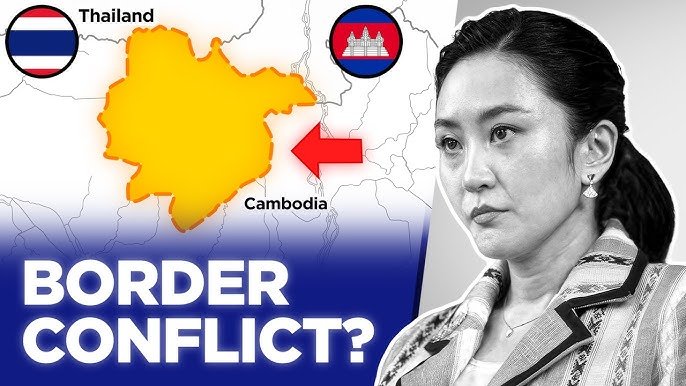The border between Thailand and Cambodia has flared up once again — and this time, things are more intense than they’ve been in years. In a dramatic turn of events, rockets, artillery, and even F-16 fighter jets have entered the fray, leaving behind destruction, injuries, and rising international concern. Let’s dive into what’s going on, what sparked this latest conflict, and why it matters.
What Sparked the Fire?
It all ignited — quite literally — on a tense Thursday morning when Cambodia fired rockets and artillery shells into Thailand, prompting the Thai military to respond with airstrikes using F-16 jets. Sounds like something out of a war movie, right? But this is the reality unfolding along one of Southeast Asia’s most volatile borders.
The heart of the matter lies in a disputed region called the Emerald Triangle, where Thailand, Cambodia, and Laos meet. This area is not just a random piece of land — it holds ancient temples and a long history of nationalist pride for both countries.
Why Is the Emerald Triangle So Important?
Imagine three nations intersecting at a single point, surrounded by temples that date back centuries. The Emerald Triangle isn’t just strategically valuable; it’s deeply symbolic. It’s like arguing over a family heirloom that both sides claim as their own — only this one comes with soldiers, mines, and airstrikes.
This border dispute isn’t new. It has been simmering for decades, with flare-ups in the 2000s and again in May this year, when a Cambodian soldier was killed. But this latest clash is different — it’s louder, deadlier, and far more public.
Thursday’s Escalation: Airstrikes and Civilian Casualties
So, what exactly happened?
At around 7:35 AM, a Thai military unit stationed near the Ta Muen temple heard a Cambodian drone overhead. A short while later, six armed Cambodian soldiers approached the barbed-wire border. Despite warnings from Thai troops, shots were fired around 8:20 AM, and within moments, Thailand had scrambled six F-16 fighter jets from Ubon Ratchathani province to hit two Cambodian military targets on the ground.
A Cambodian artillery shell also reportedly hit a civilian home in Thailand, killing one person and injuring three others — including a five-year-old child. It’s heartbreaking and infuriating.
Who Fired First? Both Sides Point Fingers
Not surprisingly, both Thailand and Cambodia are blaming each other. This is where the story gets murky — like a he-said-she-said, only with jets and rockets.
Cambodia’s Ministry of Defence claims that Thailand violated Cambodian territory and insists its forces only acted in self-defence. They argue their response aligns with international law. But on the flip side, the Thai military accuses Cambodia of starting the whole thing, even suggesting that it was a targeted attack on civilians using BM-21 rockets.
So, who’s telling the truth? That remains to be confirmed — but the damage is already done.
Thailand’s Calm But Firm Response
Thailand’s acting Prime Minister, Phumtham Wechayachai, urged restraint but made it clear: “We will do our best to protect our sovereignty.” He stressed the importance of sticking to international law, but actions on the ground suggest both countries are preparing for further escalation.
Meanwhile, the Thai embassy in Phnom Penh warned its citizens to leave Cambodia immediately unless absolutely necessary. That’s never a good sign.
Diplomatic Fallout: Ambassadors Recalled and Downgraded Ties
This clash isn’t just military — it’s political too.
Things got heated even before the rocket fire. Just hours before the artillery started flying, Thailand expelled Cambodia’s ambassador and recalled its own diplomat. Why? Because a landmine explosion injured five Thai soldiers — and Thailand blamed Cambodia for planting new mines in the disputed zone. Cambodia, of course, denies it.
Not to be outdone, Cambodia downgraded diplomatic relations, kicked out Thai diplomats (except one), and escalated the tit-for-tat tension.
Internal Trouble in Thailand
While the situation is boiling at the border, things inside Thailand are no less stormy.
Prime Minister Paetongtarn Shinawatra has been suspended over an ethics probe, and now the border conflict is adding more pressure. A leaked diplomatic call between her and Cambodia’s former ruler Hun Sen caused even more chaos, with a judicial investigation now underway in Bangkok.
It’s like a political soap opera — only the consequences are very real.
Cambodia Prepares for Conscription
And there’s more. Just last week, Cambodian Prime Minister Hun Manet announced that the country will begin conscripting civilians starting next year. That’s right — the military draft is back on the table. This move is widely seen as preparation for a longer-term confrontation with Thailand, signaling that Cambodia isn’t backing down anytime soon.
Trade Restrictions and Border Closures
If you think this is only a military and political issue, think again. The fallout has reached the economy too.
Thailand has restricted border crossings, and Cambodia has retaliated by halting some imports. It’s affecting businesses, trade, and ordinary people living near the border — many of whom rely on cross-border movement for their livelihood.
What Happens Now?
Honestly, no one knows for sure. The best-case scenario? Cooler heads prevail, diplomacy takes over, and the violence stops. The worst-case? More casualties, a drawn-out military conflict, and lasting damage to both countries’ economies and international reputations.
Right now, the region — and the world — watches closely.
Conclusion
What started as a decades-old argument over territory has exploded into deadly violence with airstrikes, civilian deaths, and shattered diplomacy. Both Thailand and Cambodia are digging in, and unless dialogue replaces gunfire soon, we may be staring down a much larger crisis.
The stakes are high, and the risks are rising. Let’s just hope both sides remember that peace is the only path forward — because in the end, it’s the people, not the politics, who suffer the most.









